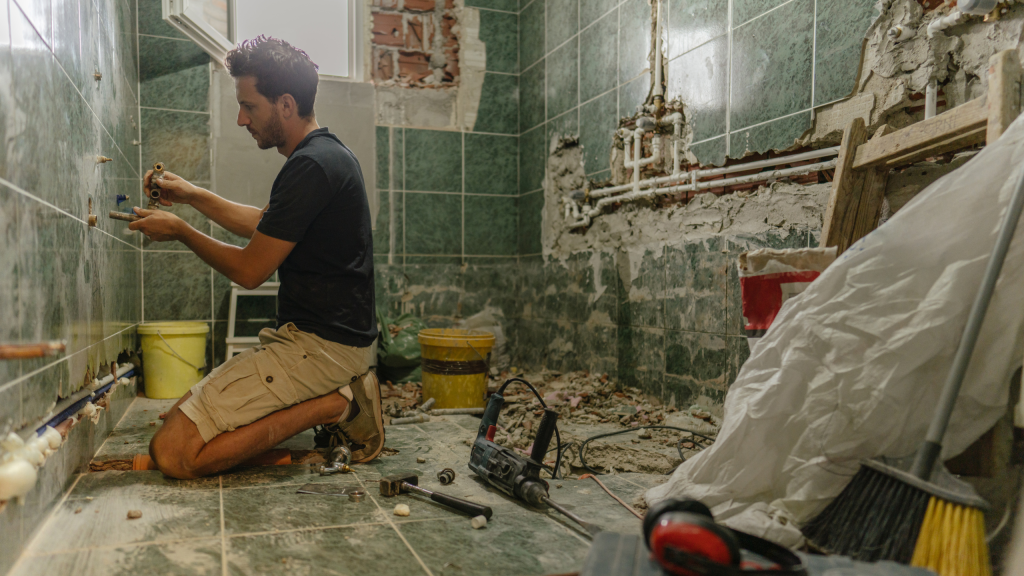Are you tired of looking at your worn-out bathtub, wishing for a fresh look? You’re not alone in feeling this way. Many people choose bathtub refinishing to give their bathrooms a makeover without overspending on full renovations. However, it’s essential to understand the financial side before deciding. This in-depth guide will break down bathtub refinishing costs in 2024 and highlight the factors that impact your spending.
Experience precision and professionalism with RC Haverford Bathtub Refinishing. Our dedicated experts and advanced tools ensure flawless outcomes. Enjoy quick service without any compromise on the final product’s quality. Book your appointment today!
Bathtub Refinishing Costs in 2024
In 2024, refinishing your bathtub typically falls between $300 and $600, depending on several factors. The material of your bathtub, whether porcelain or fiberglass, significantly affects the expenses, as each material requires different treatments. Moreover, larger tubs may require more materials and labor, increasing overall costs. Additionally, your tub’s condition is crucial; extensive damage may necessitate extra repairs, increasing the expenses further. Finally, choosing traditional or contemporary refinishing methods, such as bathtub inlays, can impact the final price. Thus, it’s essential to consider these factors when planning your bathtub refinishing project in 2024.
Factors Affecting Bathtub Refinishing Costs
Several factors can influence the cost of refinishing your bathtub:
Material: Bathtubs come in various materials like porcelain, fiberglass, acrylic, and cast iron, each impacting the refinishing cost differently.
Size: Larger tubs require more materials and labor, potentially raising the refinishing expenses.
Condition: The state of your tub significantly affects the refinishing cost. Extensive damage or tough stains may need extra preparatory work, increasing costs.
Refinishing Method: The chosen technique, whether bathtub inlays or traditional resurfacing, can impact the overall cost.
The method to refinish your bathtub can significantly affect the final price. For instance, choosing a bathtub inlay, essentially a laminate covering the tub bottom, offers a creative solution to conceal surface imperfections. These inlays provide a budget-friendly way to enhance your bathtub’s appearance. However, it’s important to consider that while bathtub inlays work well for minor imperfections, they may not be suitable for severely damaged tubs needing extensive repairs. Hence, when considering refinishing options, assessing your tub’s condition and choosing a method that aligns with your renovation objectives and budget are vital.
Cost by Type of Tub
- Porcelain: Refinishing a porcelain bathtub usually costs between $300 to $600. Porcelain tubs are renowned for their stain resistance and longevity, making them a well-liked option for homes. Refinishing can revive an aging porcelain tub, restoring its glossy finish and extending its lifespan.
- Fiberglass: Refinishing a fiberglass bathtub typically costs $300 to $600. Fiberglass tubs, prized for their lightweight build and affordability, may lose their shine over time, appearing dull or discolored. Refinishing can refresh the surface of a fiberglass tub, giving it a like-new look without the cost of replacement.
- Acrylic: Refinishing an acrylic tub comes with a slightly variable cost, typically between $350 to $700. Acrylic tubs are favored for their sleek appearance and minimal maintenance needs. Refinishing can effectively address minor scratches or chips, bringing back the smooth surface and shine of the tub.
- Cast Iron: Refinishing a cast iron bathtub tends to be on the higher end of the price range, usually from $400 to $800. Cast iron bathtubs are highly valued for their durability and timeless appeal. While refinishing a cast iron tub may require a larger investment, the results can be remarkable, transforming an old, worn-out tub into a stunning centerpiece in the bathroom.
Cost by Tub Condition
- Minor Damage or Stains: If your tub has minor damage like surface scratches or small stains, you’ll likely pay toward the lower end of the refinishing price range. Minor imperfections typically require minimal prep work, such as cleaning and sanding, before applying refinishing materials.
- Moderate Damage: Tubs with moderate damage, such as deeper scratches, chips, or discoloration, may need additional prep to achieve a smooth finish. This could involve filling in chips, repairing cracks, or applying multiple layers of refinishing materials. As a result, refinishing a tub with moderate damage may cost more than minor repairs.
- Severe Damage: Tubs with extensive damage or deep stains may require more intensive refinishing techniques. This could include thorough cleaning, addressing structural issues, or stripping previous refinishing layers before applying new coatings. Handling severe damage involves more labor and materials, which can significantly increase the refinishing cost.
Cost by Refinishing Method
- Traditional Resurfacing: Traditional resurfacing methods involve sanding down the bathtub’s current surface, addressing any damage, and applying new coatings to restore its appearance. Typically, this process costs between $300 to $600, depending on factors like tub size, material, and condition. Traditional resurfacing is versatile and suitable for many tubs, effectively handling minor to moderate damage.
- Bathtub Inlays: Bathtub inlays offer a more budget-friendly alternative to traditional resurfacing. Installing an inlay involves placing a durable laminate or acrylic panel over the existing bathtub surface to conceal imperfections and provide a fresh appearance. Bathtub inlays generally range from $200 to $400, making them appealing to homeowners looking to enhance their tub’s appearance without the expense of a complete refinishing project. However, it’s essential to consider that while bathtub inlays can effectively address minor surface damage, they may not be suitable for tubs with severe damage requiring extensive repairs.
Conclusion
Grasping the expenses tied to bathtub refinishing is essential for planning your renovation budget effectively. Considering factors such as your tub’s material, size, condition, and the selected refinishing method helps you anticipate project costs accurately. Whether you opt for traditional resurfacing or modern alternatives like bathtub inlays, there are options to suit different budgets. With thoughtful thought and preparation, you may offer your bathtub a makeover without going over budget.

